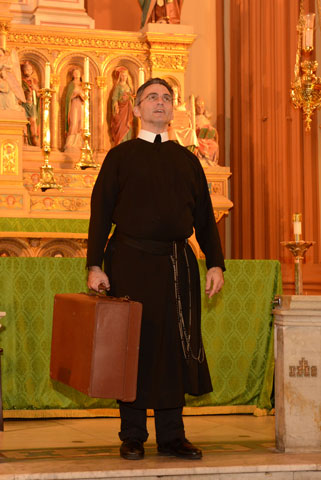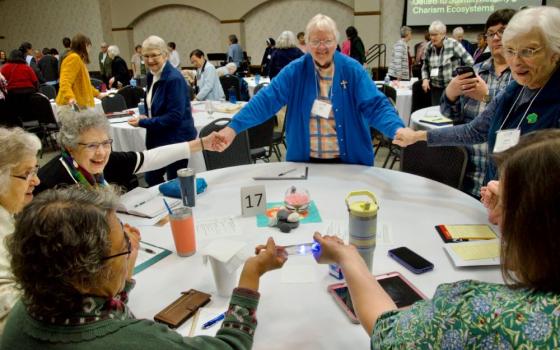
Casey Groves plays Blessed Francis Xavier Seelos at the shrine in New Orleans dedicated to the 19th-century Redemptorist priest. (Bill Croskey)
Voices cry out in the quiet church, pleading for the priest to alleviate physical and spiritual suffering. They are filled with anguish coupled with hope. "Say a prayer for me, Father ..."
As if responding to their call, the man these beseechers have put their faith in enters slowly from the back. Wearing a black Victorian cassock and wire-framed glasses, he takes his place before the altar and the voices are stilled. The priest who will heal these troubles has arrived.
With this simple yet powerful beginning, actor and playwright Casey Groves brought his new one-man play, "Seelos: Doctor of Souls," to Manhattan's St. Paul the Apostle Church. The 90-minute work, which Groves developed over a year and a half, features 28 characters and tells the story of Blessed Francis Xavier Seelos (1819-67), the Bavarian-born Redemptorist priest renowned for his power to heal body and spirit.
"My intention in writing it was that it would have a healing impact on the audience," Groves said, sipping coffee and eating a giant chocolate chip cookie one February afternoon in midtown Manhattan. Groves, 42, had come north from his home in New Orleans to do 10 performances in 10 days in four states. "I want everyone to find something in Fr. Seelos' life to touch something in them."
Seelos, who died of yellow fever in New Orleans at the age of 48, was proclaimed blessed by Pope John Paul II in 2000. The miracle that earned him this distinction was the healing of Angela Boudreaux, a mother of five in southeast Louisiana with a liver cancer the size of a grapefruit. In the 1960s she prayed for intercession to Seelos and lived for another 35 years.
Being alone in the spotlight for 90 minutes, bringing to life 28 characters, would be a challenge for any actor, but Groves has been preparing for this new role, whether he knew it or not, since he was a student at De La Salle High School in New Orleans. There, he first performed "Damien," Aldyth Morris' one-man play about another real-life priest, Fr. Damien de Veuster, the Belgium-born cleric who ministered to the lepers on the Hawaiian island of Molokai. Groves has since performed that play more than 150 times.
His parents were the impetus behind this latest endeavor. They learned about Seelos at St. Mary's Assumption Parish, the church where Seelos served in the Irish Channel in New Orleans from 1866 to 1867 and where his remains are kept. Groves' parents encouraged their son to write a play about this fascinating man.
Although Groves had grown up in the city, and had 17 years of Catholic education, he had never heard of Seelos and, living in New Jersey at the time and acting in theater and on TV, he wondered if people outside of the Louisiana area would be interested.
But when he moved back with his wife, Rachel, in the fall of 2010 to explore the movie and TV opportunities that had opened in post-Katrina New Orleans, he reconsidered his parents' prompting and went online to look into Seelos' life. He was impressed to learn that people waited for up to two hours to find spiritual healing with Seelos in confession, where the priest encouraged penitents to share their stories and through his attentive listening put them at ease and brought peace to their troubled hearts.
With all that he had read conjuring up dramatic possibilities in his mind, Groves sent a proposal for a play to the National Shrine of Blessed Francis Xavier Seelos in New Orleans and received a "creative loan" for 150 hours of research, time to write, learn lines, and rehearse and collaborate over a 10-day period in New York with his director, Jesuit Fr. George Drance. In return, Groves gives back $50 from every performance to the shrine.
In creating the play -- his main source was the book Cheerful Ascetic: The Life of Francis Xavier Seelos, CSsR by Redemptorist Fr. Michael J. Curley -- Groves came up with the device of a train ride, with Seelos traveling from Chicago to New Orleans. He divided the play into seven sections, each one based on a sacrament and relating to different phases of Seelos' life. As the priest gazes out the train window, something he sees reminds him of a time in his past and he addresses the audience to tell his story.
"The train is sort of a labyrinth journey and the images along the way are the sacraments," Groves said.
The recorded petitionary prayers bring the audience into the play and Groves then dramatizes them being answered. Drance came up with the idea of ending with a recording of the same voices thanking Seelos and God for their answered prayers, an effective framing touch.
Once he had completed the initial script, Groves worked with Redemptorist Fr. Byron Miller, director of the shrine, who suggested changes to between one-third and one-half of the piece. Together they shaped the final product, with Miller promoting simplicity and Groves safeguarding the dramatic complexity of the play and the uniformity of the metaphors.
Groves says that while Seelos was remarkable in the way he could connect someone's suffering to God's healing power, he also was known for his affability and the play makes this clear as well.
Although Groves didn't choose an ordained life, he nonetheless shares Seelos' sense of mission.
"I see acting as a sacred art," he said. "Actors have the capacity to be healers, to intrepidly go where no one else wants to go, to explore the dark. It's a vocation for me. I want the work I do to look deeply into the stuff that's working and not working and find a way to make it work."
In November, he got to see just how much his work with the Seelos play is a sacred art. After a performance at St. Alphonsus Church in Wexford, Pa., near Pittsburgh, Groves found one woman with an intimate connection to Simon Sell, one of the petitioners at the start of the play and one whose voice of gratitude is heard at the conclusion.
At the last minute in developing the work, Groves decided to bring Sell into the action as a character, a man who had fallen from a scaffold in Cumberland, Md., and because of his internal injuries had not been expected to live out the day. He had six children and Groves portrays him expressing his fear to Seelos that they would be homeless without him to provide for them. Then, as Seelos, he kneels beside the gravely injured man and reassures him he will not die, that he won't be rich, but his family will always have a home. Sell was healed of his injuries and lived for another nine years.
After the performance, a middle-aged woman introduced herself as Sell's great-granddaughter.
"If Fr. Seelos hadn't healed him I wouldn't be here," she told Groves, who is still in awe of that experience.
"It was a basherte moment," he said, using a Yiddish word for something that is meant to be.
[Retta Blaney is the author of Working on the Inside: The Spiritual Life Through the Eyes of Actors, which features interviews with Kristin Chenoweth, Casey Groves, Edward Herrmann, Liam Neeson, Phylicia Rashad, Vanessa Williams and many others.]




